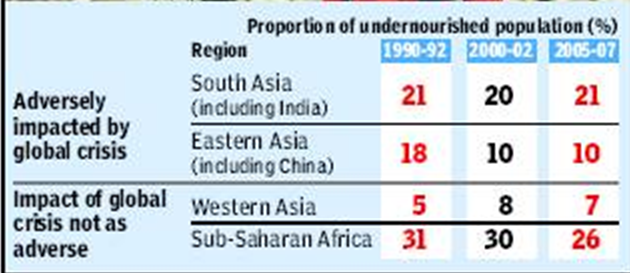Malnutrition in South Asia
This is a collection of articles archived for the excellence of their content. Readers will be able to edit existing articles and post new articles directly |
Hunger back to 1990 levels in South Asia: UN report
India Could Miss Meeting Millennium Development Goals
Himanshi Dhawan
New Delhi: Even before the food and financial crises hit the world, prevalence of hunger in South Asia was increasing instead of decreasing, taking the region further away from the goal of reducing hunger by half by 2015, according to the United Nations Millennium Development Goals report, 2010.
The report says in 2005-2007, the proportion of undernourished people in South Asia had swelled to levels last seen in 1990. The prevalence of hunger had increased from 20% in 2000-2002 to 21% in 2005-2007. The regional average was 21% in 1990-92, indicating that no progress had been made in the last two decades in reducing hunger levels and that India — the dominant country in the region — will not be able to meet its millennium development goals.
The situation has only worsened since 2007. According to UN figures, the employment to population ratio in South Asia fell to 56% in 2008 from 57% in 1998. The 2009 estimates put it even lower at 55%. An International Labour Organization report says more people got into vulnerable jobs in 2009 due to the financial meltdown. The proportion of employed people living under $1.25 a day jumped sharply from 44% in 2008 to 51% in 2009.
The UN’s latest millennium development goals report — to be released on Wednesday — says that aggregate food availability globally was relatively good in 2008 and 2009 but higher food prices and reduced employment and incomes meant that the poor had less access to that food.
Food prices spiked in 2008 and falling income due to the financial crisis further worsened the situation. UN’s Food and Agricultural Organization estimates that globally, the number of people who were undernourished in 2008 could have been as high as 915 million and exceeded one billion in 2009.
Ironically, before the onset of the global crisis, a number of regions were well on their way to halving the proportion of their undernourished population by 2015. The prevalence of hunger also declined in Sub-Saharan Africa although not at a pace that was sufficiently fast to compensate for population growth and to put the region on track to meet the MDG target.
In East Asia, after a striking drop in the prevalence of hunger in the 1990s, the rate of malnourishment has stalled at 10% between 2000 and 2007. Southeast Asia, which was already close to the target of cutting the hunger rate in half against 1990 levels, made additional progress, but not as rapid as its rate of poverty reduction.
